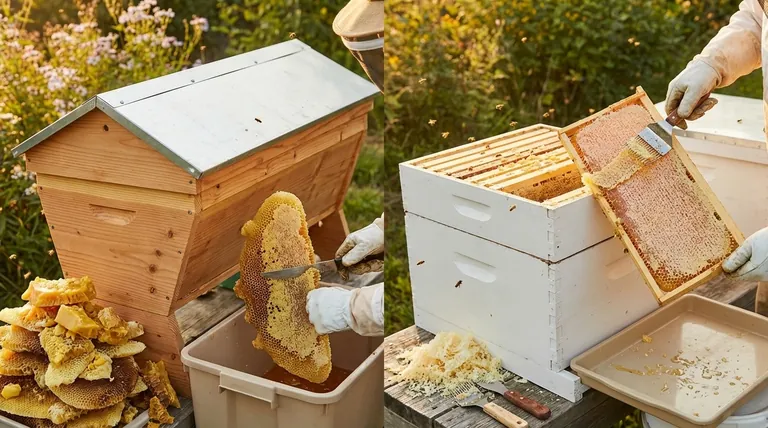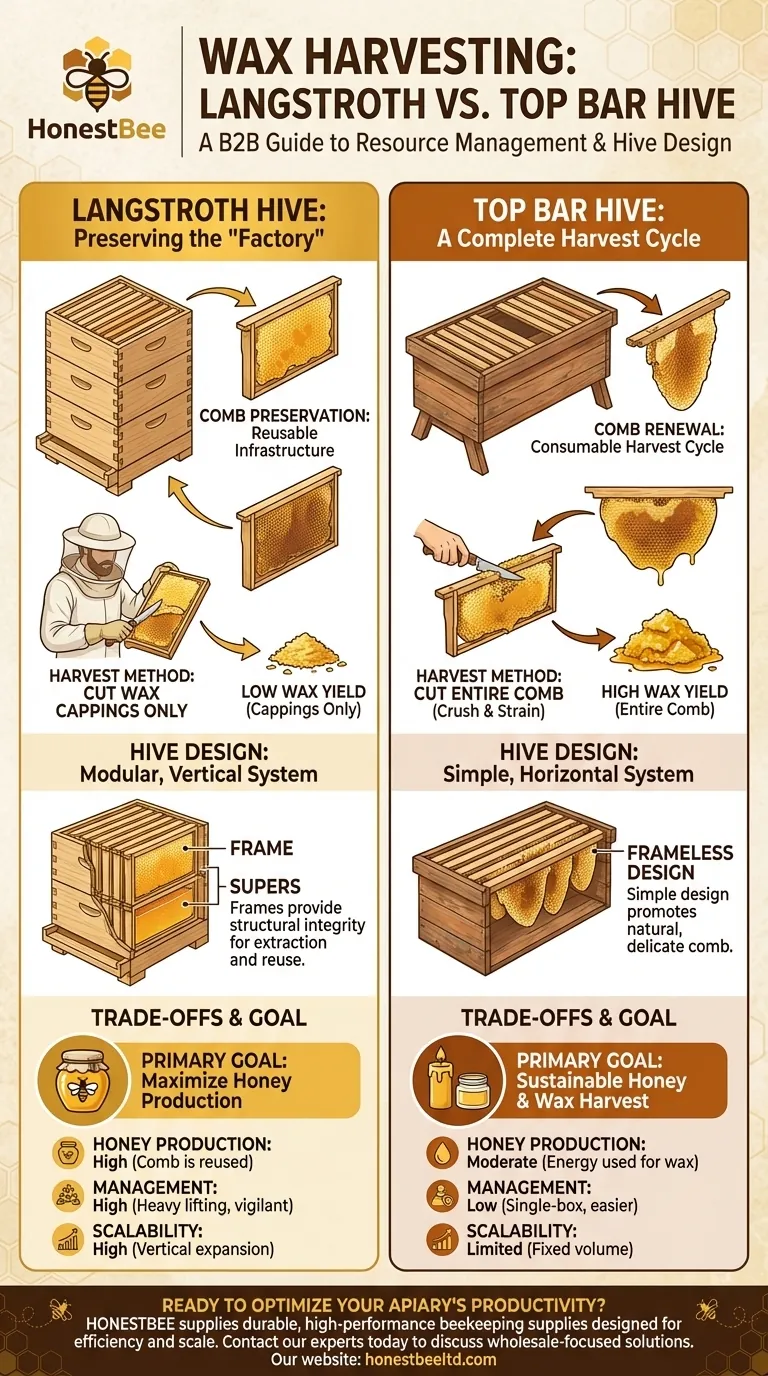The fundamental difference in wax harvesting between a top bar hive and a Langstroth hive is determined by the hive's core design and philosophy. In a top bar hive, the entire comb is cut out during a harvest, resulting in a substantial yield of beeswax. In a Langstroth hive, only the thin wax "cappings" are removed, leaving the structural comb intact for the bees to reuse and yielding very little wax.
Your choice of hive is a choice between two distinct resource management strategies. A Langstroth hive prioritizes the bees' energy for honey production by preserving their comb, while a top bar hive operates on a cycle of comb renewal that yields a significant wax harvest as a byproduct.

The Core Difference: Comb Preservation vs. Comb Renewal
The philosophy behind each hive directly impacts what you harvest. One system treats the comb as reusable infrastructure, while the other treats it as a consumable part of the harvest cycle.
The Langstroth Method: Preserving the "Factory"
In a Langstroth hive, bees build their comb on frames, often guided by a foundation. This creates durable, uniform combs that can be used for many years.
Bees expend a tremendous amount of energy to produce wax and construct this comb. The Langstroth system is designed to preserve this investment.
During a honey harvest, the beekeeper uses a special knife or fork to slice off only the top layer of wax cappings used to seal the honey cells. The underlying comb structure—the "factory"—is returned to the hive for the bees to refill, maximizing their efficiency for honey production.
The Top Bar Method: A Complete Harvest Cycle
In a top bar hive, bees build their comb naturally, hanging down from simple wooden bars without the support of a full frame. This results in more fragile, cross-linked comb.
Because the comb is not supported by a frame, it cannot be placed in a centrifugal extractor. The only practical harvesting method is to cut the entire comb from the top bar.
This "crush and strain" method separates the honey from the wax. While it requires the bees to rebuild the comb, it provides the beekeeper with a significant and continuous supply of fresh beeswax with every harvest.
Why Hive Design Dictates the Harvest
The physical structure of each hive is the root cause of these different harvesting outcomes. It's a classic case of form dictating function.
Langstroth Hives: A Modular, Vertical System
A Langstroth hive is composed of vertically stacked, interchangeable boxes. The brood chamber is for raising young, and additional boxes, called "supers," are added on top for honey storage.
The key feature is the frame. These wooden or plastic frames provide structural integrity, allowing combs to be removed, inspected, and placed in an extractor without being destroyed. This entire system is engineered for comb reuse.
Top Bar Hives: A Simple, Horizontal System
A top bar hive is a single, long horizontal box. Instead of frames, it uses simple wooden bars that span the width of the hive.
Bees build their comb directly from these bars without any side or bottom support. This frameless design is simpler and promotes natural comb construction, but it also makes the comb too delicate to survive extraction. Harvesting requires its removal.
Understanding the Trade-offs
Neither system is inherently better; they are optimized for different goals, and each comes with clear trade-offs.
Wax Yield vs. Honey Production
A Langstroth hive is the clear winner for maximizing honey production. By reusing comb, bees can dedicate nearly all their resources to foraging and making honey, rather than rebuilding their home.
A top bar hive produces a much higher wax yield—often considered a valuable second harvest. This comes at the cost of some honey production, as the bees must constantly expend energy to draw new comb.
Management Style and Physicality
Top bar hives are often favored for their ease of management. Because it is a single box, there is no need to lift heavy supers, which can weigh over 50 pounds (23 kg) in a Langstroth system.
Langstroth hives require more vigilant management and heavy lifting. The beekeeper must add and remove heavy boxes to align with the colony's growth and nectar flow to prevent swarming.
Scalability
Langstroth hives are highly scalable. As a colony grows, you simply add more boxes. This makes them ideal for large-scale or commercial honey production.
Top bar hives have a fixed internal volume. While they are long, they cannot be expanded, which can limit the ultimate size of the colony and may require more advanced swarm management techniques.
Making the Right Choice for Your Goal
The choice between these hives depends entirely on what you want to achieve as a beekeeper.
- If your primary focus is maximizing honey production: The Langstroth hive is the superior choice, as preserving the comb allows bees to focus their energy entirely on making honey.
- If your primary focus is a sustainable harvest of both honey and wax: The top bar hive is ideal, providing a significant and regular wax harvest for candles, balms, or other crafts.
- If your primary focus is ease of management and minimal heavy lifting: The top bar hive's single-box design is far less physically demanding than managing a multi-box Langstroth hive.
Ultimately, your choice of hive determines your relationship with the bees and the resources you will harvest, so select the system that best aligns with your personal beekeeping philosophy.
Summary Table:
| Feature | Langstroth Hive | Top Bar Hive |
|---|---|---|
| Harvest Method | Cut wax cappings only | Cut entire comb (crush & strain) |
| Wax Yield | Low (cappings only) | High (entire comb) |
| Comb Reuse | Yes, comb is preserved | No, bees rebuild comb |
| Primary Goal | Maximize honey production | Sustainable honey & wax harvest |
| Physical Demand | High (heavy lifting) | Low (single-box design) |
| Scalability | High (vertical expansion) | Limited (fixed volume) |
Ready to optimize your apiary's productivity? Whether you manage a large commercial operation or supply equipment to distributors, the right hive and tools are critical. HONESTBEE supplies durable, high-performance beekeeping supplies and equipment designed for efficiency and scale.
Contact our experts today to discuss how our wholesale-focused solutions can help you maximize your honey yield, streamline your wax harvesting, and build a more profitable beekeeping business.
Visual Guide

Related Products
- Top Bar Beehive for Beekeeping Wholesales Kenya Top Bar Hive
- Long Langstroth Style Horizontal Top Bar Hive for Wholesale
- HONESTBEE Advanced Ergonomic Stainless Steel Hive Tool for Beekeeping
- Professional Dual-End Stainless Steel Hive Tool for Beekeeping
- Wholesales Dadant Size Wooden Bee Hives for Beekeeping
People Also Ask
- What is the quickest method to harvest honey from a top bar hive? A Guide to the Simple 'Cut and Crush' Method
- How should a beekeeper prepare a top-bar hive for overwintering? A Guide to Ensure Colony Survival
- Why are hive inspections easier with Top Bar Hives? Achieve a Calmer, Safer Approach to Beekeeping
- How is honey harvested from a top-bar hive? A Guide to Simple, Low-Equipment Processing
- What are the labor requirements for a KTBH vs. Langstroth hive? A Guide for Apiary Efficiency



















